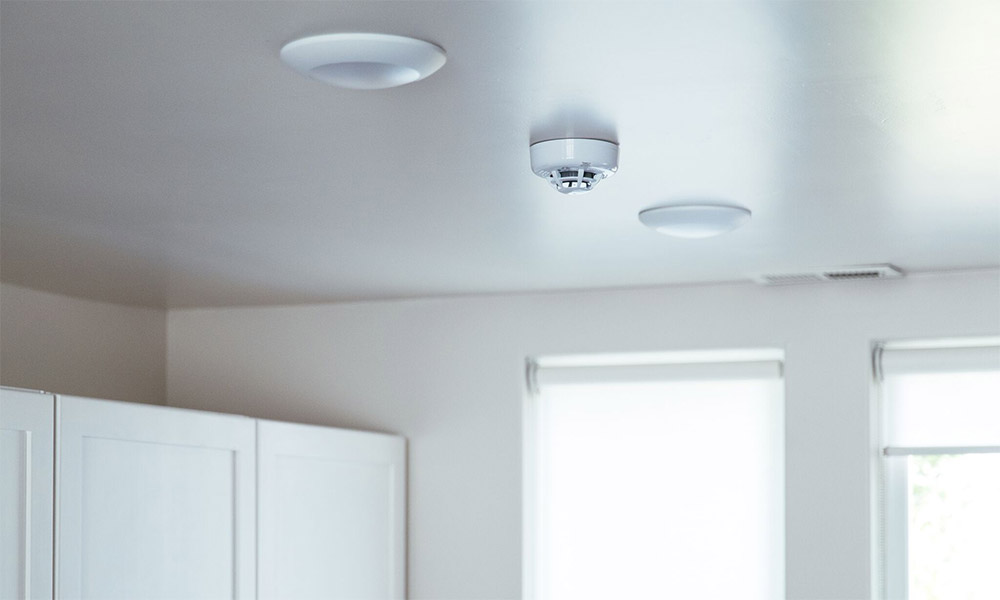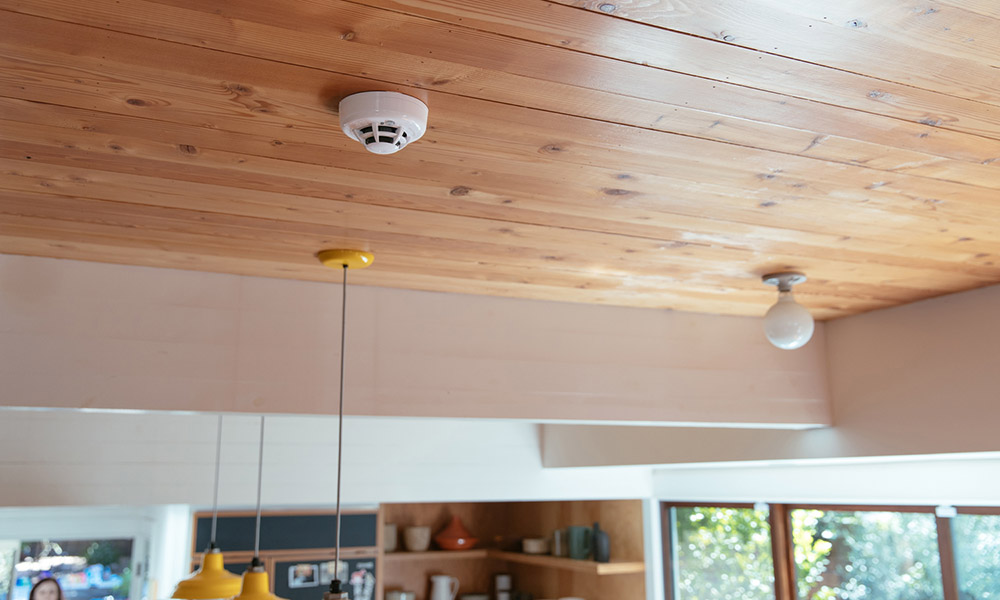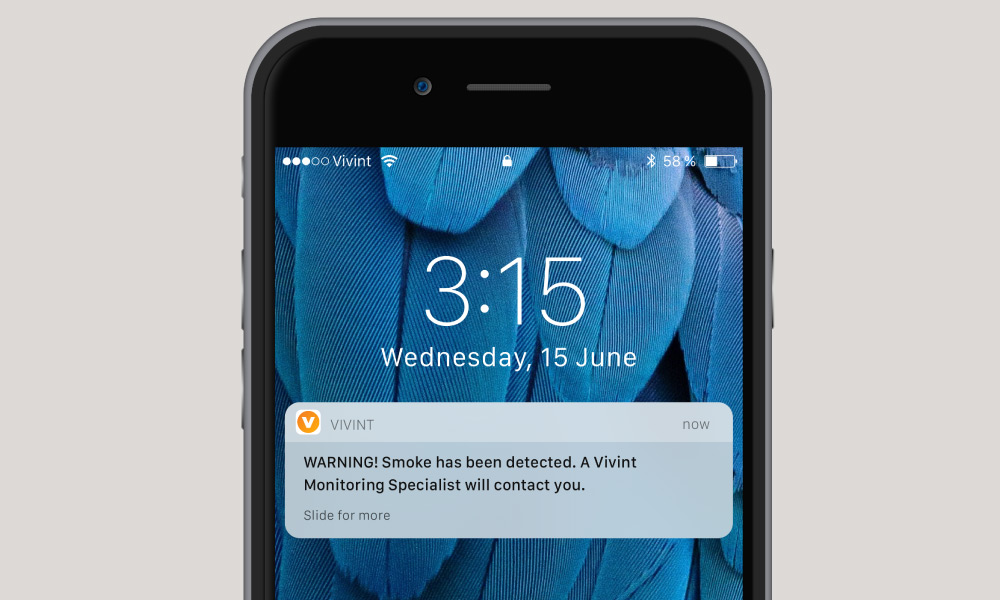Installing your smoke alarms correctly – and making sure they are in working order – is an important step to making your home and family safer from fire.
It’s important to have enough smoke alarms in your home. Fire research has demonstrated that with today’s modern furnishings, fires can spread much more rapidly than in the past when more natural materials were used. Because of this, having a sufficient number of properly located smoke alarms is essential to maximize the amount of available escape time. For many years NFPA 72, National Fire Alarm and Signaling Code, has required as a minimum that smoke alarms be installed inside every sleep room (even for existing homes) in addition to requiring them outside each sleeping area and on every level of the home. (Additional smoke alarms are required for larger homes.) Homes built to earlier standards often don’t meet these minimum requirements. Homeowners and enforcement authorities should recognize that detection needs have changed over the years and take proactive steps make sure that every home has a sufficient complement of smoke alarms.
Installation guide

Planning and Implementing a Successful Smoke Alarm Installation Program
A smoke alarm installation program in your community can make a measurable difference in reducing deaths and injuries from fire. The updated “Planning and Implementing a Successful Smoke Alarm Installation Program” (PDF) is a comprehensive guide including everything you’ll need to get started, from tips on how to select volunteers, to pointers on soliciting donations and publicizing your program.
Download the program.
Installing smoke alarms
- Choose smoke alarms that have the label of a recognized testing laboratory.
- Install smoke alarms inside each bedroom, outside each sleeping area and on every level of the home, including the basement.
- On levels without bedrooms, install alarms in the living room (or den or family room) or near the stairway to the upper level, or in both locations.
- Smoke alarms installed in the basement should be installed on the ceiling at the bottom of the stairs leading to the next level.
- Smoke alarms should be installed at least 10 feet (3 meters) from a cooking appliance to minimize false alarms when cooking.
- Mount smoke alarms high on walls or ceilings (remember, smoke rises). Wall-mounted alarms should be installed not more than 12 inches away from the ceiling (to the top of the alarm).
- If you have ceilings that are pitched, install the alarm within 3 feet of the peak but not within the apex of the peak (four inches down from the peak).
Figure A.29.8.3.1 from NFPA 72, National Fire Alarm and Signaling Code (2013 edition). - Don’t install smoke alarms near windows, doors, or ducts where drafts might interfere with their operation.
- Never paint smoke alarms. Paint, stickers, or other decorations could keep the alarms from working.
- For the best protection, interconnect all smoke alarms. When one smoke alarm sounds they all sound. Interconnection can be done using hard-wiring or wireless technology.
- When interconnected smoke alarms are installed, it is important that all of the alarms are from the same manufacturer. If the alarms are not compatible, they may not sound.
- There are two types of smoke alarms – ionization and photoelectric. An ionization smoke alarm is generally more responsive to flaming fires, and a photoelectric smoke alarm is generally more responsive to smoldering fires. For the best protection, both types of alarms or combination ionization-photoelectric alarms, also known as dual sensor smoke alarms, are recommended.
- Keep manufacturer’s instructions for reference.
Testing smoke alarms
- Smoke alarms should be maintained according to manufacturer’s instructions.
- Test smoke alarms at least once a month using the test button.
- Make sure everyone in the home understands the sound of the smoke alarm and knows how to respond.
- Follow manufacturer’s instructions for cleaning to keep smoke alarms working well. The instructions are included in the package or can be found on the internet.
- Smoke alarms with non-replaceable 10-year batteries are designed to remain effective for up to 10 years. If the alarm chirps, warning that the battery is low, replace the entire smoke alarm right away.
- Smoke alarms with any other type of battery need a new battery at least once a year. If that alarm chirps, warning the battery is low, replace the battery right away.
- When replacing a battery, follow manufacturer’s list of batteries on the back of the alarm or manufacturer’s instructions. Manufacturer’s instructions are specific to the batteries (brand and model) that must be used. The smoke alarm may not work properly if a different kind of battery is used.
Interconnected smoke alarms increase safety
In a Consumer Product Safety Commission (CPSC) survey of households with any fires, including fires in which the fire department was not called, interconnected smoke alarms were more likely to operate and alert occupants to a fire.1 People may know about a fire without hearing a smoke alarm.
- When smoke alarms (interconnected or not) were on all floors, they sounded in 37% of fires and alerted occupants in 15%.
- When smoke alarms were not on all floors, they sounded in only 4% of the fires and alerted occupants in only 2%.
- In homes that had interconnected smoke alarms, the alarms sounded in half (53%) of the fires and alerted people in one-quarter (26%) of the fires.
Protecting your home against fire. It’s nothing to be taken lightly. Do you know what’s available in smoke detector technology, and have you taken the time to fortify your home against fire?
Whether you have smoke detectors installed, you have them, and your batteries are low, or your home is currently without them, here’s what you need to know about these life-saving devices.
Heat detectors: the original smoke alarms
The oldest form of fire-detection device is a heat detector. It functions simply with a detection element inside the device that activates when it reaches a fixed temperature or an extreme increase in temperature occurs.
Heat detectors may be ideal only if speed in sensing smoke and fire is not of great concern, or if space is small and confined where fast-burning, high-heat fires are likely to occur. But neither of these scenarios lends itself to residential fire protection.1
So when you think of safeguarding your home against fire, forget heat detectors. Smoke detectors are where it’s at.
They’re going to sense the presence of extreme heat, smoke, and fire faster than a heat detector. And they’ve proven much more effective in detecting fires in residential homes.2 If you don’t have smoke detectors installed in your home, get them. If you have them, make sure they’re in working order, and batteries are kept current.
How do smoke detectors work
The oldest form of fire-detection device is a heat detector. It functions with a detection element that activates when it reaches a fixed temperature or an extreme increase in temperature occurs. Aside from heat detectors, you have three options when it comes to smoke detectors: ionization, photoelectric, or a combination of the two.
How do you choose the right smoke detectors for your home?
OK. We know we need smoke detectors. But do you have any idea how they actually work?
If the answer is no, not to worry. You’re in the majority. Most people aren’t aware of how, exactly, a smoke detector does its job. But just in case you’re curious how these life-saving devices work, we’re here to tell you.

Ionization vs. photoelectric smoke detectors
Aside from heat detectors, you have three options when it comes to smoke detectors: ionization, photoelectric, or a combination of the two. Let’s take a look:
Ionization smoke alarms
These smoke detectors are much more responsive to fast, raging fires and flames. They contain a small amount of radioactive material that passes between two electrically charged plates, which create an ionization chamber. This configuration ionizes the air and creates a current that flows between the plates. If smoke enters that space, it absorbs alpha particles and disturbs the ionization process, which reduces the current and activates the alarm.
Photoelectric smoke alarms
These types of detectors typically respond better to smoldering fires—essentially those that begin with a long period of smoldering. Photoelectric alarms work using a photoelectric sensor and a light source. As smoke enters the chamber and crosses the path of the light beam, light is scattered by the smoke particles, aiming it toward the sensor, which in turn triggers the alarm.
For best protection, use both types of smoke alarm technologies
Combination smoke detectors utilize both technologies—ionization and photoelectric. With the capabilities of both in place, you increase your chances of being alerted to fire and protecting your family should this type of emergency arise. In fact, The National Fire Protection Agency (NFPA) recommends using both technologies to get the most protection for your home.3

Residential fires that result in fatalities, no matter what time of day, include both smoldering and flaming fires. And since it’s impossible to predict not only the occurrence of fire but also the type of fire that may strike, having both forms of smoke-detection technology is the way to go.
You’ll get the earliest warning signs possible, no matter what type of fire, what time of day, and whether you’re asleep or awake. And if you install detectors that come with a monitoring service, your home is protected even when you’re away—whether it’s quick, rapid flames or a fire that smolders for some time.
How to get the best smoke detection coverage for your home
So how do you go about accomplishing this?
If your existing alarms are photoelectric, you can purchase ionization detectors and place one beside each photoelectric unit. If you’re not sure what kind of detectors you’re dealing with, check your owner’s manual. Or just remove the smoke detector and look at the back—you’ll find either the word “photoelectric” or “ionization” or simply the initial letters of the words.
If it’s in the budget you could also consider replacing your smoke detectors altogether with combination units. These dual-sensor devices feature both ionization and photoelectric technologies working in tandem. With these units, you get the convenience and peace of mind of both types of technologies working together in a single device.
Smoke detector placement and operation procedures
Once you know what you need in terms of smoke detector technology, how do you determine how many detectors you need and where to place them?
According to the NFPA, detectors should be installed:
- inside every bedroom,
- outside each sleeping area, and
- on each level of the home.
Bigger homes will obviously need more fire alarms than smaller homes.4
If you install smoke detectors as part of a comprehensive smart home system, they can connect on a single platform so that when one alarm triggers, all of the smoke detector alarms in the house will sound. Notifications are sent to your system’s control panel and you’ll receive them on your mobile device as well.

If you opt for a Vivint Smart Home system, our monitoring and support specialists are always ready to hear the alarm—even when you’re not home—and contact emergency services when you can’t. This additional layer of security further protects your home and loved ones and offers you peace of mind no matter where you are.

